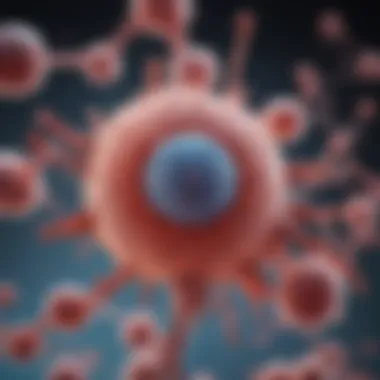Exploring Stem Cells for Osteoarthritis Treatment


Intro
Osteoarthritis is a degenerative joint disease that affects millions worldwide. Characterized by the breakdown of cartilage, it leads to significant pain and functional limitations. Traditional treatments often focus on relieving symptoms rather than addressing the core issues that cause cartilage degradation. As a result, there is a growing demand for innovative solutions in the management of osteoarthritis. Stem cell therapy has emerged as a potential game-changer in regenerative medicine, offering hope for not only symptom relief but also the restoration of joint health. This article will explore various aspects of stem cells in osteoarthritis management, including their types, mechanisms, and contemporary research findings.
Research Background
Overview of the Scientific Problem Addressed
Osteoarthritis arises when the cartilage that cushions the joints wears away, often due to aging, injury, or repetitive stress. Currently available treatments, such as non-steroidal anti-inflammatory drugs (NSAIDs) and corticosteroids, primarily mitigate pain but fail to slow down or reverse the degenerative process. The limitations of these therapies underscore the necessity for more effective approaches.
Historical Context and Previous Studies
Stem cells have been a focus of scientific research for many years. Initially, they were considered mainly in the context of hematological diseases and potential applications in tissue engineering. Over the past two decades, studies have begun to highlight the capability of stem cells to differentiate into cartilage cells, known as chondrocytes. In 2006, the first significant assessment of mesenchymal stem cells (MSCs) for osteoarthritis began to gain traction. Various trials have illustrated how these cells can aid in cartilage repair and regeneration. However, significant knowledge gaps about the optimal sources of stem cells, delivery methods, and long-term effects remain.
Findings and Discussion
Key Results of the Research
Recent findings indicate that MSCs can effectively promote cartilage regeneration and reduce inflammation. Studies have shown that both autologous and allogenic stem cells can be beneficial in treating knee osteoarthritis. These cells can modulate the local immune response, thus halting further degeneration.
Interpretation of the Findings
The results of these studies indicate that the therapeutic potential of stem cells in osteoarthritis management is significant, yet they also highlight the complexity of the relationship between stem cells and joint health. Factors such as patient age, the severity of joint damage, and the type of stem cells used can significantly affect outcomes. Future research must focus on standardizing treatment protocols and determining the long-term effects of stem cell therapies.
"While stem cells offer promise, ongoing education and research are essential for effective application in clinical settings."
Preamble to Osteoarthritis
Osteoarthritis is a condition that affects millions of individuals worldwide. It is essential to have a comprehensive understanding of osteoarthritis, especially when assessing the role of innovative treatments such as stem cell therapy. Traditional approaches often address the symptoms rather than the root cause, leaving a gap that regenerative medicine aims to fill. The exploration of this disease opens avenues for improved quality of life for affected patients.
Definition and Prevalence
Osteoarthritis is a degenerative joint disease marked by the breakdown of cartilage. Cartilage serves as a cushion between bones, permitting smooth joint movement. Over time, this tissue becomes worn down, leading to pain, stiffness, and dysfunction. Estimates suggest that approximately 30 million adults in the United States suffer from osteoarthritis, making it a leading cause of disability.
The prevalence increases with age, affecting nearly 50% of individuals aged 65 and older. However, younger populations are not immune. Factors such as obesity, joint injuries, and genetic predisposition can contribute to early onset.
"Understanding the definition and prevalence of osteoarthritis is vital for grasping the potential impact of stem cell therapies."
Pathophysiology of Osteoarthritis
The pathophysiology of osteoarthritis involves complex biological processes. At the core of this disease is cartilage degradation, but it also includes inflammation and changes in subchondral bone. The primary mechanism begins with cartilage wear and tear. Enzymes like matrix metalloproteinases play a significant role in breaking down cartilage.
Inflammatory cytokines, such as interleukin-1 and tumor necrosis factor-alpha, contribute to joint swelling and pain. This inflammatory response further exacerbates cartilage damage and may lead to a vicious cycle of joint deterioration. Tissue remodeling and impaired repair mechanisms also characterize the condition.
Understanding the intricate pathology provides insights into potential therapeutic interventions. When considering stem cells, it is crucial to recognize how they may offer healing at cellular levels. Their ability to modulate inflammation, repair tissues, and differentiate into cartilage-like cells positions them as potential candidates for innovative treatments.
Understanding Stem Cells
Understanding stem cells is crucial in the context of osteoarthritis management. This section elucidates the various types of stem cells and their functions, primarily focusing on their therapeutic potential. Stem cells have unique properties that make them suitable for regenerative medicine. They can differentiate into various cell types and possess a capacity for self-renewal. This makes them particularly appealing for treatments aimed at repairing damaged tissues, such as cartilage affected by osteoarthritis.
Types of Stem Cells


Stem cells can be categorized into different types, each with distinct characteristics and applications. The distinction among these types is important for understanding their roles in potential therapies for osteoarthritis.
Embryonic Stem Cells
Embryonic stem cells are derived from early-stage embryos and have the unique ability to differentiate into any cell type in the body. This pluripotency is significant for research and therapeutic applications. They can potentially regenerate damaged cartilage due to their inherent capability to transform into joint tissue. However, ethical concerns arise regarding their sourcing from embryos. This aspect limits their widespread application in clinical settings.
Key characteristics:
- Pluripotency: Ability to differentiate into any cell type.
- High regenerative capacity: Capable of creating various tissue types, including cartilage.
Advantages and disadvantages:
- Advantage: Broad potential for diverse applications in regeneration.
- Disadvantage: Ethical and legal barriers hinder research and clinical use.
Adult Stem Cells
Adult stem cells are found in various tissues after development and are involved in repairing and maintaining those tissues. They are multipotent, meaning they can differentiate into a limited range of cell types related to their tissue of origin. For osteoarthritis treatment, mesenchymal stem cells, often sourced from bone marrow or adipose tissue, are a notable choice. They have shown potential in reducing inflammation and repairing damaged joint tissues.
Key characteristics:
- Multipotency: Limited to certain cell types based on origin.
- Easier ethical acceptance: Less controversial than embryonic stem cells.
Advantages and disadvantages:
- Advantage: Ethical acceptance and availability from non-embryonic sources.
- Disadvantage: Limited differentiation potential compared to embryonic stem cells.
Induced Pluripotent Stem Cells
Induced pluripotent stem cells are a groundbreaking development achieved by reprogramming adult somatic cells to regain pluripotency. This innovation allows for the creation of stem cells that can mimic the properties of embryonic cells, without the associated ethical issues. These cells can potentially provide patient-specific therapies for osteoarthritis, minimizing rejection risks and improving treatment outcomes.
Key characteristics:
- Reprogrammability: Adult cells transformed into pluripotent cells.
- Potential for personalized therapy: Cells derived from the patient reduce compatibility issues.
Advantages and disadvantages:
- Advantage: Combines the benefits of embryonic and adult stem cells without ethical dilemmas.
- Disadvantage: Further research is needed to ensure their safety for clinical use.
Mechanism of Action
Understanding the mechanism of action of stem cells in osteoarthritis is vital for appreciating their therapeutic potential. Stem cells act primarily through several avenues: regeneration of damaged tissues, modulation of inflammation, and paracrine signaling, which involves the secretion of bioactive factors into the microenvironment to promote healing. These factors can play roles in pain relief and tissue repair, making stem cell therapy a promising option for managing osteoarthritis patients.
Stem Cell Applications in Osteoarthritis
The utilization of stem cells for managing osteoarthritis marks a significant development in therapeutic strategies aimed at addressing the underlying causes of the disease rather than merely alleviating symptoms. Existing treatments often focus on pain management and mobility enhancement without targeting cartilage deterioration. The application of stem cells introduces the possibility of regenerating damaged tissues and restoring joint function. This section discusses the current landscape of stem cell applications in osteoarthritis, underscoring the importance, potential benefits, and considerations associated with this approach.
Clinical Trials Overview
Clinical trials represent the cornerstone of evaluating new treatment modalities. In the realm of stem cell therapies for osteoarthritis, numerous trials have begun to provide valuable data on efficacy and safety. These trials typically involve the administration of stem cells derived from various sources, such as bone marrow, adipose tissues, or umbilical cord blood. Researchers track outcomes such as pain reduction, functional improvement, and overall quality of life for participants.
A critical aspect of these trials is the variability in approaches. Different studies may use distinct types and dosages of stem cells, as well as varied methods of delivery to the target site. As of now, there are several ongoing and completed trials that have shown promise. Initial findings suggest that certain stem cell therapies could lead to clinical improvement in pain and joint function.
"Stem cell therapy holds potential to fundamentally change the treatment landscape for osteoarthritis, moving away from symptomatic management to underlying repair."


It is essential for researchers and stakeholders in regenerative medicine to consider the methodologies employed in these trials. Clarity in protocols yields more robust and reproducible results, providing a solid foundation for future applications.
Case Studies
Case studies serve as practical examples illustrating the impact of stem cell therapies on individuals suffering from osteoarthritis. They provide insights into real-world applications and patient experiences. Several documented cases demonstrate significant improvements in pain management and physical mobility following stem cell treatments.
For example, a notable case involved a patient receiving adipose-derived stem cells. Post-treatment evaluations indicated a marked reduction in joint pain and an enhancement in joint functionality. Similarly, another case highlighted the use of bone marrow-derived stem cells, which resulted in positive outcomes over an extended follow-up period.
These case studies help validate findings from clinical trials and contribute to the understanding of how stem cells can influence the healing process of osteoarthritis. They also serve to identify best practices and potential complications, which are crucial for clinicians considering such therapies.
In summary, the applications of stem cells in the management of osteoarthritis show great promise. Clinical trials are essential in formalizing the therapeutic process, while case studies provide grounding examples of real-life outcomes. Both aspects together can lead to more significant advancements in the field.
Source of Stem Cells
The source of stem cells plays a critical role in their effectiveness and potential applications in osteoarthritis management. Different types of stem cells can be obtained from various tissues, and their origin influences their properties, including differentiation potential and immunogenicity. Understanding these differences is essential for advancing therapeutic strategies using stem cells.
Bone Marrow-Derived Stem Cells
Bone marrow-derived stem cells are one of the most studied types in the context of osteoarthritis. They are primarily composed of mesenchymal stem cells (MSCs), which have the potential to differentiate into cartilage, bone, and adipose tissue. Their ability to promote regeneration and modulate inflammation makes them particularly appealing for treating joint disorders.
One of the major advantages of bone marrow-derived stem cells is their capacity to secrete various bioactive molecules that can help in cartilage repair and reduce inflammation. These factors include cytokines and growth factors that promote healing.
However, extracting bone marrow is an invasive procedure, leading to discomfort for the patient. The quantity of stem cells obtained can also be limited, especially in older individuals, posing a challenge for effective treatment.
Adipose Tissue-Derived Stem Cells
Adipose tissue-derived stem cells are gaining attention for their ease of accessibility and abundance. These cells, also known as adipose-derived mesenchymal stem cells (ADSCs), can be harvested through minimally invasive liposuction procedures.
ADSCs have shown promising results in preliminary studies related to their capacity to differentiate into chondrocytes, thus contributing to cartilage regeneration. They also exhibit anti-inflammatory properties, which can be particularly beneficial in managing osteoarthritis symptoms.
On the downside, ADSCs may not have the same regenerative capacity as bone marrow-derived stem cells. Moreover, their long-term efficacy and safety need to be assessed in larger clinical trials.
Umbilical Cord-Derived Stem Cells
Umbilical cord-derived stem cells are an emerging focus in stem cell therapy. These cells are rich in nucleated cells and have high proliferative capacity. They can differentiate into various cell types, including chondrocytes, making them a suitable candidate for treating osteoarthritis.
The key advantage of using umbilical cord-derived stem cells is that they pose almost no risk to the donor and can be obtained without invasive procedures. Furthermore, they have shown immunomodulatory properties, which may reduce the risk of rejection when transplanted into patients.
Nevertheless, there is a need for further research to determine the optimal ways to utilize these stem cells in regenerative therapies for osteoarthritis.
In summary, while each type of stem cell source presents unique advantages and disadvantages, ongoing research continues to elucidate their roles in osteoarthritis management. A combination of these diverse stem cell types may hold the key to effective treatment strategies.
Challenges and Limitations
In the context of stem cell therapies for osteoarthritis, addressing the challenges and limitations is crucial. This exploration aids in understanding the complexity of integrating stem cell treatments into standard care. Regulation, ethical considerations, and technical issues all play significant roles in the trajectory of research and application. A comprehensive grasp of these matters is essential, as they can guide future research and clinical implementations.
Regulatory Hurdles
Regulatory frameworks significantly influence the development of stem cell therapies. Different countries have varying regulations regarding stem cell research and treatment. In the United States, for instance, the Food and Drug Administration (FDA) oversees the approval of stem cell therapies. The process can be lengthy and complex, often deterring innovative approaches. Researchers must navigate these regulatory pathways to ensure that therapies are safe and effective. This can lead to delays in getting new treatments to patients.
Moreover, the lack of standardized regulations often results in inconsistencies in research quality. Not all stem cell products are created equal, and without rigorous oversight, dubious treatments may emerge in the marketplace.
Ethical Considerations


Addressing ethical aspects is paramount in stem cell research. Many stem cell types, particularly embryonic stem cells, raise ethical questions regarding their source. The debate often revolves around the moral status of the embryo. Different cultures and belief systems influence opinions on what is acceptable in this research field. Additionally, the consent process for using human tissues remains a significant ethical consideration. Ensuring that donors are fully informed of how their cells will be used is critical.
Understanding and addressing these ethical dilemmas can play a role in public perceptions of stem cell research. A transparent approach can enhance trust and acceptance from the community, which is often a barrier to the advancement of new therapies.
Technical Difficulties
Technical challenges abound in the realm of stem cell therapy for osteoarthritis. One major difficulty is ensuring the consistency and quality of stem cell products. Variability in stem cell populations can lead to differing treatment outcomes. Scientists must establish protocols that ensure the stability and efficacy of the stem cells used in clinical settings.
Another technical challenge involves the delivery mechanism. How stem cells are administered can affect their effectiveness. Developing methods that enhance stem cell survival and integration into damaged tissues is essential for therapeutic success. This area of research is ongoing and requires collaboration between various scientific disciplines.
In summary, the challenges and limitations associated with stem cell therapy in osteoarthritis management are multifaceted. Regulatory, ethical, and technical hurdles must be adequately addressed to realize the potential of these innovative treatments.
Future Directions in Stem Cell Therapy
The exploration of stem cell therapy continues to evolve rapidly. As research reveals more about the complexities of osteoarthritis, new therapeutic strategies emerge. The potential of stem cells in this context is not only significant but also requires careful consideration of various factors. Innovative approaches can pave the way for more effective treatment options. Personalized medicine stands out as a critical direction that aims to tailor treatments to individual patient needs. This focus can enhance efficacy and minimize adverse effects.
Innovative Approaches
Emerging techniques are reshaping the landscape of stem cell therapy in osteoarthritis. One of the notable advancements is the use of scaffolding materials. These materials provide a supportive structure for stem cells, enhancing their integration and effectiveness in damaged tissues. Researchers are also investigating the use of bioengineered tissues, which can create a more conducive environment for stem cells to thrive and regenerate cartilage.
Additionally, combining stem cell therapy with growth factors can improve results. These factors facilitate stem cells to differentiate into specialized cells that can repair cartilage. Moreover, gene editing technologies, such as CRISPR, are showing promise in enhancing the regenerative capabilities of stem cells. By modifying specific genes, scientists hope to boost the healing properties of stem cells even further.
Personalized Medicine
The concept of personalized medicine is crucial for the future of stem cell therapy in osteoarthritis. Each patient's condition is unique, influenced by genetic, environmental, and lifestyle factors. Tailoring treatments accordingly can lead to better outcomes. For example, genetic profiling can identify which patients are more likely to respond positively to specific types of stem cells, making it possible to select the most effective therapy.
Furthermore, having the ability to modulate the patient's immune response could enhance the integration of transplanted stem cells, reducing rejection risks. Developing predictive models based on individual variations could guide healthcare providers in making informed decisions regarding treatment strategies.
In essence, the shift towards personalized medicine may redefine how stem cell treatments for osteoarthritis are approached, making them more effective and patient-centered.
In summary, the future of stem cell therapy in osteoarthritis management hinges on innovative approaches and personalized strategies. While challenges remain, the progress in these areas offers hope for improved therapies and outcomes for patients grappling with this degenerative condition.
Closure
The examination of the therapeutic potential of stem cells in managing osteoarthritis is not just timely but crucial for advancing treatment methodologies. This article has explored various facets of stem cell therapy, shedding light on their types, mechanisms, applications, and the current state of research, as well as the challenges faced in integrating these therapies into mainstream practice.
Summary of Findings
Throughout this article, the complexity of osteoarthritis has been highlighted, alongside the limitations of conventional treatment options that primarily focus on symptom relief rather than underlying pathology. Key findings reveal that stem cells, with their ability to regenerate and differentiate into various cell types, provide a pathway to not only alleviate symptoms but also potentially reverse some damage to joint tissues. Evidence from clinical trials indicates promising results, suggesting that stem cell therapy could lead to improved function and reduced pain for many patients. The discussion included:
- Types of Stem Cells: A detailed review of the different sources of stem cells such as bone marrow, adipose tissue, and umbilical cord, emphasizing their respective advantages and limitations in treating osteoarthritis.
- Mechanisms of Action: The biological processes through which stem cells exert their effects, including anti-inflammatory actions and the promotion of cartilage repair.
- Clinical Applications: Insights from ongoing studies and successful case reports that provide a glimpse into the real-world applications of stem cell therapy.
- Challenges and Ethical Considerations: Addressed vital obstacles such as regulatory constraints and ethical debates that must be navigated to facilitate the broader acceptance and implementation of stem cell treatments.
These insights contribute to a nuanced understanding of how regenerative medicine could reshape the future landscape of osteoarthritis management.
The Path Ahead
Looking into the future, the potential of stem cells in osteoarthritis management offers both hope and necessitates cautious exploration. Ongoing and future research efforts must continue to focus on innovating delivery methods, optimizing cell types used, and personalizing treatment regimens based on patient-specific factors. Moreover, as research progresses, collaboration among scientists, clinicians, and regulatory bodies will be essential to uncovering best practices and ensuring that stem cell therapies become a standard of care rather than an experimental modality.
Parsing through the complexities of this subject reveals a landscape ripe with possibilities. With continued advancements in technology and a deeper understanding of stem cell biology, the horizon for osteoarthritis treatment is expansive, calling for sustained investment in research and patient education. As we look toward a future where stem cell therapy is integrated into clinical practice, our commitment to ethical standards and effective methodologies must guide these efforts to ensure successful outcomes for all patients.
Importance of References
- Credibility: An article is only as credible as the sources it cites. Utilizing authoritative references lends credibility to the claims made regarding stem cell therapy.
- Contextual Understanding: The history and evolution of research are illuminated when analysis is supported by previous studies. Other researchers and healthcare professionals can gain a comprehensive understanding of the subject.
- Guidance for Future Research: References not only show where the field has been but also suggest areas that need further exploration. They help identify gaps in knowledge that can be crucial for advancing treatment methodologies.
Specific Elements to Consider
- Diversity of Sources: Various types of research, including systemic reviews, clinical trials, and experimental studies, provide a well-rounded perspective on stem cell therapy.
- Up-to-Date Literature: Citing the most current studies ensures that the discussion reflects the latest findings in the field. This is essential in a discipline where techniques and understanding evolve quickly.
- Interdisciplinary Works: Recognizing references from different domains, such as immunology and regenerative medicine, adds depth to the discussion, enriching our understanding of osteoarthritis management.
The references listed aid in constructing a solid foundation for the arguments presented in this article. They empower readers to delve deeper into the subject matter and explore various avenues of research that can potentially enhance therapies for osteoarthritis management.







